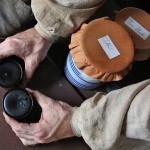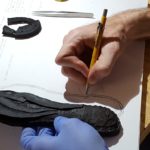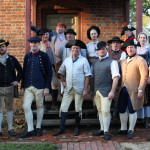
Al Saguto would like to clear up a few things. Interpreting historic trades is usually a pretty safe business, explains the Master of the Shoemaker Shop. Most are keeping alive crafts that the average person has only a passing familiarity with.
Shoes are different. We all wear them, and we’ve absorbed facts and anecdotes mixed with assumptions and tall tales. The misconception are what Al would like to quash. He calls setting the record straight “killing Geppetto,” and following are his top myths the Shoemakers hear every day…
Myth #1 The Quaint Little Workshop
Many imagine the shoemaker—like Geppetto—working alone in the quiet of a small workshop, lovingly crafting each pair of shoes from toe to heel. Some of our favorite childhood stories, like Pinocchio or The Elves and the Shoemaker, reinforce this image. In the 18th century such a fanciful workman would be out of business before he got his first pair finished.
A typical Virginia shop might have anywhere from half a dozen to twenty-odd shoemakers—one in 18th-century London employed 160. The centuries-old division of labor had the master of the shop cutting the leather parts, the “closer” sewing the pieces (the uppers) together, and then the crew of journeyman putting all of these readied parts together, maybe at the pace of one pair in a twelve-hour workday for each journeyman. Together, they would knock out dozens of pairs a week, but none were working on a single shoe at a time.
We know of at least a dozen shops manufacturing shoes at the same time in Williamsburg in the 1770s, and even more in larger cities (800 firms in London). It was a leading industry into the 20th century.
Shops, some called “factories,” manufactured either men’s (leather) or women’s (textile) shoes. Few tried making both because the materials, tools, workmanship, and styles were radically different. However, a few shops sold both, buying what they didn’t manufacture themselves from London wholesale shoe warehouses.
In cases where both were made in the same shop, the work would be divided – probably into different rooms, and certainly with different workmen – into “stuff makers” (makers of women’s shoes) and “men’s men” (makers of men’s leather shoes).
Myth #2 The “Simple Cobbler”
18th-century shoemakers were neither “simple” nor technically even “cobblers”. But the phrase still echoes in some heads, mine included, thanks to the 1970s musical, “1776.”
In one memorable scene, the members of the committee appointed to write the Declaration of Independence demur from the task one after the other. When it comes to Roger Sherman, the character expresses his reluctance in song:
Mr. Adams, but, Mr. Adams
I cannot write with any style or proper etiquette
I don’t know a participle from a predicate
I am just a simple cobbler from Connecticut
Sherman was, in fact, a skilled shoemaker, who probably would have punched you if you dared called him a cobbler. For centuries before, cobblers were relegated to mending old shoes using old leather, rather than making them. Over time Americans have gotten a little sloppy with the terms, and they are often used incorrectly, or, by the late 19th century, conflated.
As for “simple,” shoemakers were far from uneducated. Sherman is just one example, but shoemaking was historically a very literate trade, witness Hans Sachs, “The Nightingale of the Reformation,” Samuel Lane, a New Hampshire shoemaker whose library of over 300 books would put many to shame, and many others, including a disproportionate number of published poets compared with other trades.
So you can see why a shoemaker wouldn’t want to be equated with a “clumsy or bungling workman” (that is, a cobbler). Who would you rather have making your shoes?
Myth #3 Shoes were luxury items
Shoes were no more or less a luxury item than they are today. Everyone wore them, needed them, most bought four pair a year, and the variety of prices and qualities was comparable to what you see today. There was a huge market for reconditioned secondhand shoes from London on the cheap end. But if you had too much money, or just the desire to be a fashionista, they could also be quite expensive.
Like today, a custom-made item could be more exquisite, which made it more expensive, therefore putting it beyond some people’s price range—it was all about consumer choices, then as now. Buying on credit was big in 18th-century Virginia, and people bought plenty of things they couldn’t afford, just like we do today.
It’s impossible to accurately equate colonial Virginia currency to modern dollars—the fiat exchange rate (“par of exchange”) changed annually, and valuation of goods was so different that numbers can be misleading. But typically a pair might cost from half a crown to over a pound, two pounds for riding boots.
The median shoe price in Virginia was five shillings sixpence, which equates to just less than an average day’s wages for the journeymen working for George Wilson’s shop on piece-wages, not hourly/salary, potentially 80-90 Pounds Virginia money annually. There was no income tax back then, so no need to religiously compute your annual income.
So what’s the bottom line? In Al’s estimation, the takeaway is that few 18th-century Williamsburgers needed to spend more than a day’s wages for any one of the four pair of shoes a year they bought because of the wide price range available, but some were frugal, others not.
Myth #4 All shoes were custom-made
Retail and wholesale ready-made shoes, not custom-made footwear, had been driving the shoe industry for centuries by the 1770s, even before it was mechanized. Machines didn’t become part of the process until the 1860s-80s.
Shoes were big business. The American colonies imported some 300,000 pairs a year from London. One Londoner held a series of annual licenses to export “400,000 dozen” shoes a year!
Any shoemaker would go out of business sitting around and waiting for the next, ahem, well-heeled customer to come in and place a custom order, so he stocked his shop with “Sale Shoes”, the most popular styles ready-made in the most common sizes.
When Wilson’s Williamsburg shop was burglarized in March of 1774, 19 or 20 pairs were stolen, probably all the lone thief could manage to carry rather than his entire inventory.
Myth #5 People only owned a single pair of shoes at a time
Perhaps feeding off the myth that 18th-century shoes were all custom-made, or the clever marketing of today’s leading “bespoke” (custom) shoemakers, who still do some hand-sewing, some boldly charging north of $8,000(!) a pair, is that a single cherished pair must have lasted a lifetime and was all you needed.
Today hand-sewn shoes are a luxury—in the 1770s that was simply the way all shoes were made.
But by the 1750s, in Virginia just like England, most people bought about four pairs of shoes a year. Like today, you needed to have footwear suitable for a variety of purposes.
At any given time, the average person might own one or two pairs of common shoes for everyday use, slippers for indoors, and dress shoes for church and other more formal occasions. And dancing pumps were no huge luxury either.
Riding boots would have been a luxury item, like a horse to wear under them. Of course, wealthier folks had more cash (or credit) and might have owned a wider assortment of shoes.
Orphans and residents of the Williamsburg poorhouse were issued two pairs a year. So were slaves, apprentices, and soldiers. In a city like Williamsburg, barefootedness was hardly an option. People knew that you could contract worms walking barefoot, and Duke of Gloucester Street was, after all, “a mile long, 100 feet wide, and a foot deep.”
Myth #6 18th-century shoes were uncomfortable
So, OK if the shoes didn’t last forever, they must have actually been terrible, right? How comfortable could hard leather be compared to the modern comfort of our overly-padded high-tech sneakers?
Pretty comfortable, actually. All-leather shoes are so rarely worn today that few people even know how nice they can be. The assumption that “new” is better leads too often to the conclusion that old ways are bad. But synthetic footwear is hot, doesn’t breathe, and never fully conforms to your foot—and let’s not even mention sloppy fitting. Heavily-padded, over-supportive modern footwear actually robs your feet of natural momentum by absorbing too much energy, thus fatiguing your muscles and, research suggests, contributing to the increasing number of degenerative joint injuries.
The natural oak-bark-tanned 18th-century leather quickly conforms to the shape of a foot, even becoming a natural “footbed” — better than any slip-in orthotic insole that merely floats loose inside a shoe that’s too big to begin with, says Al.
Not convinced? Rob, an apprentice shoemaker, wore a pair made in the shop on a 12-mile march at a battle reenactment a couple of weeks ago.
Myth #7 Right & left shoes were not invented until the Civil War
A final widespread misconception, seemingly at odds with the notion that shoes were anything like comfortable, is that both shoes were the same shape for both feet, because “right and left were not invented yet.”
Most 18th-century shoes were indeed made from the same pattern because it was cheaper and quicker, but once the wearer attached their shoe buckles and wore them, the shoes quickly formed to that foot and the matter was settled. Many also cut off the under-strap, permanently assigning the shoe to buckle only on one foot.
A related myth is that shoes were interchangeable by design, allowing people to swap left and right daily, like rotating car tires, to make them last longer.
But the best 18th-century book written for shoemakers warns us that switching back and forth ruined the shoes rather than prolonging their life, and the feet were constantly pained especially when the shoes were new. Imagine wearing the wrong shoe on the wrong foot every day!
The archaeological record confirms that only a handful of about 5,000 surviving period shoes from the region show any evidence of swapping.
So there you have it. As different as colonial America was, it had its share of similarities. It even had a little swagger.
Sailors wore their shoes “sailor fashion,” swaggering around with one buckle strap flapping out of the buckle and tugged to the front; others in the backcountry and German-speaking areas turned both buckle straps outward to flap up and down like mule ears, tying them with a string—kind of like wearing your cap backwards or loose-lacing your Timberland work boots.
If you’d like to know even more, just drop by the shop—or order a specially-priced copy of Art of the Shoemaker, Al’s annotated translation of an 18th-century classic.



Good example of specialized tasks in handmade process to foster quality control of ready made shoes for the masses back then to buy at shops when needed. Good point that shops more likely stayed afloat where they had ready made inventory on hand! Great example of negating occupational stereotypes with regard to educated/cultural level!! London shoe shops would be admired these days on their shoe refurbishment/ thrift shop style sales!!
Well said Mr. Saguto!
Gepetto was a toy maker not a cobbler.
Toymaker? I thought Gepetto was a woodcarver….
Excellent article!! Answers many questions received by interpreters especially dealing with rights and lefts.. .
I’m highly intrigued by the description of wearing shoes “sailor fashion”. What’s the documentation for that, and when was this fashionable? A friend, Kyle Dalton, whose blog “British Tars:1740-1790” goes into detail on the manner and dress of sailors, would probably live to research this, if he hasn’t, already. Likewise, those of us who do impressions of sailors of the period, would likely want to have this info.
Terrific article!Thanks!
Al, Val and Rob at the Shoemaker Shop were able to provide some details:
The image here is a detail from Watson and the Shark, oil, 1778, by John S. Copley, showing both buckle straps pulled “toward the toe,” though not un-tucked.
There is a quotation: “nor should they [soldiers] be permitted to have their shoe straps pulled towards the toe like Sailors; but are to be accustomed to tuck the ends of them under the rim of the buckle.” Bennet Cuthbertson, System for the Complete Interior Management and Œconomy of a Battalion of Infantry (Bristol, 1776), 113-114.
And here’s a link to 3 more images showing later 18thc British sailors with straps untucked/pulled forward: http://www.christies.com/lotfinder/prints-multiples/after-henry-singleton-ra-british-plenty-and-5075197-details.aspx
Not a complete list of references, but hope this helps!
My father was a shoemaker and even owned his own shoe factory. The shoemaker’s shop is one of my favorite places to visit. I love the smell of leather! This article was fascinating, I learned a lot of interesting facts. I can’t wait to come back!
Can you buy any of these hand made shoes at CW?
I checked with Al, our Master of the Shop. He replied: “Regrettably no. Our tiny shop only holds a tiny staff, so our production rate is small, and there are hundreds of costumed employees in queue each year for authentic footwear to better portray the 18thc across the Historic Area for guests to CW.”
And pigs are a big source of hookworm. My understanding was that bigs sometimes ran loose, eating garbage, even in town? So folks could definitely get worms through their feet. The way it was written here made it sound like it was an archaic idea that had been disproven.
You are correct. I edited that sentence to make that point clear. Thank you.
Very informative. And yes, if one walks about barefooted, one may very well get worms, especially if one walks where horses have done what horses do.